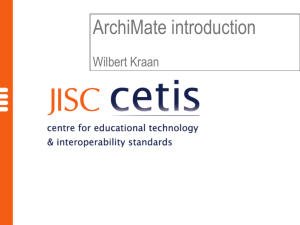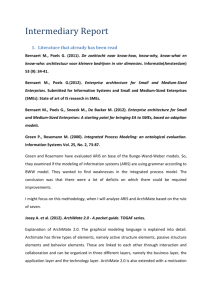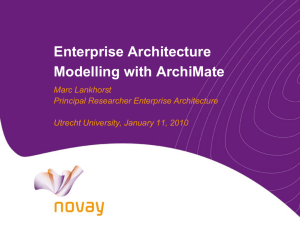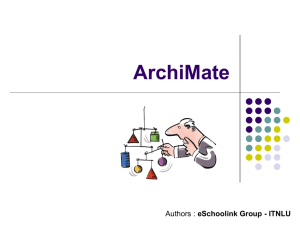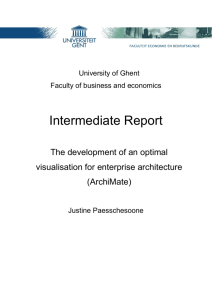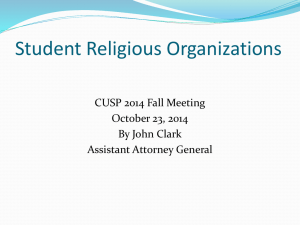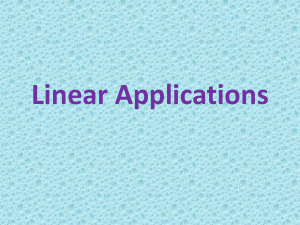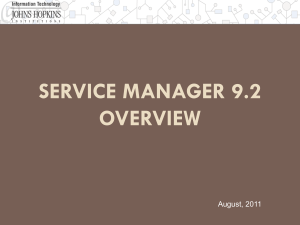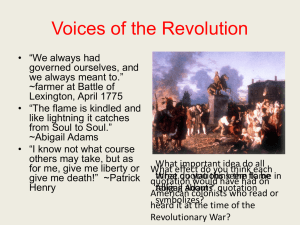Enterprise Architecture Modeling With ArchiMate & Sparx
advertisement
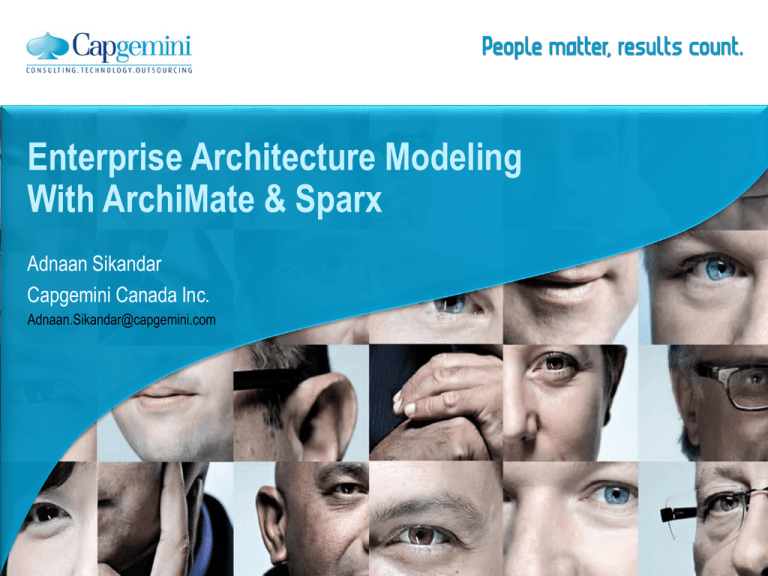
Enterprise Architecture Modeling With ArchiMate & Sparx Adnaan Sikandar Capgemini Canada Inc. Adnaan.Sikandar@capgemini.com AGENDA ArchiMate Overview ArchiMate Concepts • Framework & Concept • Layers • Metamodels ArchiMate Viewpoints • • • • • Information Structure Viewpoint Business Process Viewpoint Layered Viewpoint Infrastructure Viewpoint TOGAF ADM Viewpoints ARCHIMATE What is it? • ArchiMate is a modeling language for describing enterprise architectures • Broader scope than UML. UML is for software engineering • Supports EA frameworks like TOGAF & Zachman • Can be used to create IAF views and artifacts • ArchiMate viewpoints are more detailed than TOGAF’s architecture artifacts – TOGAF does not provide descriptions and examples ARCHIMATE Which version should I use? • Technical Specification 1.0 (Approved) • Technical Specification 2.0 (Under Review) Is it a standard? • The Open Group’s ArchiMate Forum – Stewards of the ArchiMate standard What about the license? • Capgemini is an ArchiMate Forum member • ArchiMate Forum members have commercial license to use it for consulting engagements ArchiMate – Concepts ARCHIMATE FRAMEWORK Products & Services Business Application Information Data Processes Business Functions Organisation Applications Technical Infrastructure Technology Information Behavior Structure ARCHIMATE CONCEPT ArchiMate Structure - Services Customer External business service Business Internal business service External application service Application Internal application service External infra. service Technology Internal infra. service ARCHIMATE STRUCTURE - LAYERS Layers • Business Layer - Offers products and services to external customers, which are realized in the organization by business processes performed by business actors • Application Layer - Supports the business layer with application services which are realized by (software) applications. • Technology Layer - offers infrastructure services (e.g., processing, storage, and communication services) needed to run applications, realized by computer and communication hardware and system software. Generic Metamodel For Each Layer External Internal Object Information Service Interface Behavior element Structure element Behavior Structure METAMODEL – BUSINESS LAYER LANGUAGE NOTATIONS BUSINESS LAYER - SPARX EXAMPLE Actors Tier 1 Help Desk Agent IT Help Desk Assigned To Assigned To Exception Management Process SMI Events Exceptions Flows Triggers Create Event (Automatic) Flows Correlate & Analyze Event (Automatic) Flows Triage & Resolve Exception Ticket Close Exception Ticket METAMODEL – APPLICATION LAYER METAMODEL – TECHNOLOGY LAYER ArchiMate – Viewpoints Basic ArchiMate Viewpoints Introductory Viewpoint Organization Viewpoint Actor Co-operation Viewpoint Business Function Viewpoint Business Process Viewpoint Business Process Co-operation Viewpoint Product Viewpoint Application Behavior Viewpoint Application Co-operation Viewpoint Application Structure Viewpoint Application Usage Viewpoint Infrastructure Viewpoint Infrastructure Usage Viewpoint Implementation and Deployment Viewpoint Information Structure Viewpoint Service Realization Viewpoint Layered Viewpoint Landscape Map Viewpoint ACTOR CO-OPERATION VIEWPOINT Layered View Point Stakeholders Enterprise, process, and domain architects Concerns Relations of actors with their environment Purpose Designing, deciding, informing Abstraction Level Details Business layer Business layer Aspects Structure, behavior ACTOR CO-OPERATION VIEWPOINT Service Desk Service Desk Manager Business Actor A Operations Optimization Business Actor B «Tickets» «Tickets» «Tickets» Tier 1 Service Desk Business Actor C «Tickets» «Tickets» «Tickets» Tier 2 Applicaiton Administration «Tickets» Tier 2 System Administration «Tickets» Tier 2 Network Administration Business Actor D LAYERED VIEWPOINT Layered View Point Stakeholders Enterprise, process, application, infrastructure, and domain architects Concerns Consistency, reduction of complexity, impact of change, flexibility Purpose Designing, deciding, informing Abstraction Level Overview Layer Business layer, application layer, technology layer Aspects Information, behavior, structure LAYERED VIEWPOINT – SPARX EXAMPLE Actors Tier 1 Help Desk Agent IT Help Desk Exception Management Process SMI Events Exceptions Create Event (Automatic) Correlate & Analyze Event (Automatic) Triage & Resolve Exception Ticket Close Exception Ticket Application Services Event Logging Service Event Correlation Service Event Analysis Service Ticket Service Work Instructions Service Trouble Ticket Management Knowledge Management Application Components Event Correlation & Analysis Applications BMC Event Manager BMC Remedy ITSM BUSINESS PROCESS VIEW POINT Business Process View Point Stakeholders Process and domain architects, operational managers Concerns Structure of business processes, consistency and completeness, responsibilities Purpose Designing Abstraction Level Detail Layer Business layer Aspects Behavior BUSINESS PROCESS VIEW POINT – SPARX EXAMPLE Actors IT Help Desk Tier 1 Agent IT Help Desk Process Event Correlate & Analyze Event (Automatic) Create Event (Automatic) Resolve Exception Ticket Create / Read Read Close Exception Ticket Update Update Create Create / Update Read Read Read Read Network Topology Event Read Network Device Asset Rules Device Event Thresholds Exception Ticket INFRASTRUCTURE VIEW POINT Business Process View Point Stakeholders Infrastructure architects, Operational Managers Concerns Stability, security, dependencies, infrastructure costs Purpose Designing Abstraction Level Detail Layer Technology Aspects Behavior, Structure INFRASTRUCTURE VIEW POINT – SPARX EXAMPLE Mobile Field Force Database Security Context Mobile Field Force Application Security Context SSL Database Internet Information Server Windows Windows HTTPS Secure Zone Corporate LAN HTTPS HTTPS HTTPS Office Application Internal Firewall Private APN HTTPS Mobile Tablets APPLICATION LANDSCAPE VIEW POINT Baseline Application Model Level 1 Process Existing System A Existing System B Existing System C Existing System D Existing System E Existing System F Target Application Model Level 1 Process Existing System A Existing System B Existing System C New System X New System Y New System Z Existing System D Existing System E Existing System F ARCHIMATE RESOURCES ArchiMate 1.0 Technical Specification ArchiMate Good Practices Sparx Enterprise Architect ArchiMate Presentations

